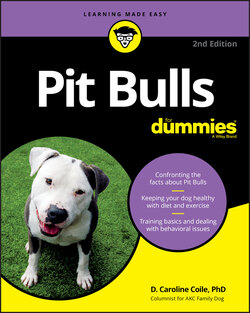Читать книгу Pit Bulls For Dummies - D. Caroline Coile - Страница 38
UKC conformation shows
ОглавлениеShows sponsored by the UKC offer the following classes:
Puppy: For dogs 6 months to under 1 year of age.
Junior: For dogs 1 year to under 2 years of age.
Senior: For dogs 2 years to under 3 years of age.
Veteran: For dogs 3 years of age and over.
Breeder-Handler: For dogs over 6 months handled in the ring by that dog’s breeder or a member of the breeder’s immediate family
All the males are shown first. Class winners are awarded 10 points toward their Championship and then compete within their sex for Best Male of Show (worth another 15 points). Then all the females are shown, and a Best Female of Show is awarded. Best Male and Female of Show then compete for Best of Winners (worth another 10 points). This is followed by the Champion of Champions class, in which male and female Pit Bulls who have already earned a UKC Champion title compete, and then by the Grand Champion class, in which only male and female Pit Bulls who have already earned a UKC Grand Champion title compete. Finally, the Best of Winners, the Champion of Champions winner, and the Grand Champion winner compete for the Best of Breed.
It’s all about the points. To become a UKC Show Champion, your Pit Bull must win 100 UKC championship points, awarded by three different judges, and win either a Best Male or Best Female of Show. Because it’s possible to win points even if a dog is the only one in his class, a further requirement is that at least two of the wins must be over competition. A Grand Championship is earned by beating other Pit Bull champions (in the Champion of Champions class) in at least five shows under at least three different judges. Grand Champions compete against each other in the Grand Champion class.
The official UKC breed club, the National American Pit Bull Terrier Association, can hold a special National Grand Champion class at their fall National show, in which Grand Champions compete. The winner of this competition is declared the National Grand Champion and awarded the NTL GR CH title as part of his name.
What if you want to enter a UKC show but you haven’t had a chance to register your dog? You can get a Temporary Listing from the UKC if your dog is not registered by calling the UKC at 616-343-9020 (and paying by credit card).
If you’ve spent any time around other dog breeds, you probably know that the AKC is the breed registry that governs most conformation dog shows in the United States. American Staffordshire Terriers are one of almost 200 breeds seen at a typical AKC show. Only a few UKC shows are for all UKC breeds, however; most UKC shows are for one or perhaps a handful of the most popular UKC breeds. Pit Bulls are one of the UKC’s most popular breeds, and a large percentage of UKC shows have classes for American Pit Bull Terriers. Due to the unique history of the Pit Bull, the UKC governs most shows in which Pit Bulls compete.
Some ways in which UKC shows differ from AKC shows include
No grooming in the ring. Grooming is not allowed in the ring. This means no brushes, cloths, or spray bottles.
No using gizmos to get your dog’s attention. You can’t use squeakers, food, keys, or other artificial means of getting your dog’s attention. You’re allowed just your voice and your fingers.
No professional handlers are allowed in the ring. In AKC shows, many top dogs are handled by slick pros instead of their owners.
These rules help focus the judge’s attention on the dog’s structure rather than on the handler’s ability. Dogs in a UKC show are shown in a more natural manner than are those in an AKC show. That doesn’t mean that you can just show up with an untrained dog and expect to start lugging home ribbons. Your dog will need to know how to stand still in a show pose. For the Pit Bull, this means that the front legs are perpendicular to the ground and parallel to one another, with the feet facing forward. The hocks of the rear legs are perpendicular to the ground and parallel to one another, and the feet face forward. The dog should stand straight up on his toes, and may lean slightly forward. His head should be held high. The judge will need to examine his body, so he will need to hold his pose while allowing a stranger to touch him all over. He can act neither shy nor aggressive toward the judge. He will also need to trot in a straight line at your side, neither balking, lunging, nor galloping. He will be doing this in a ring with other Pit Bulls, so he must be under your control at all times.
